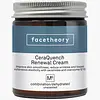What's inside
What's inside
 Key Ingredients
Key Ingredients

 Benefits
Benefits

 Concerns
Concerns

 Ingredients Side-by-side
Ingredients Side-by-side

Water
Skin ConditioningGlycerin
HumectantPersea Gratissima Fruit Butter
EmollientGlyceryl Stearate Se
EmulsifyingArgania Spinosa Kernel Oil
EmollientOlea Europaea Fruit Oil
MaskingSimmondsia Chinensis Seed Oil
EmollientOlive Glycerides
EmulsifyingCetyl Alcohol
EmollientStearic Acid
CleansingRosa Moschata Oil
AstringentTocopherol
AntioxidantRetinyl Palmitate
Skin ConditioningPanthenol
Skin ConditioningSodium Ascorbyl Phosphate
AntioxidantSodium Levulinate
Skin ConditioningSodium Anisate
AntimicrobialSodium Hyaluronate
HumectantCeramide NP
Skin ConditioningUbiquinone
AntioxidantLactic Acid
BufferingFerulic Acid
AntimicrobialXanthan Gum
EmulsifyingGlyceryl Caprylate
EmollientWater, Glycerin, Persea Gratissima Fruit Butter, Glyceryl Stearate Se, Argania Spinosa Kernel Oil, Olea Europaea Fruit Oil, Simmondsia Chinensis Seed Oil, Olive Glycerides, Cetyl Alcohol, Stearic Acid, Rosa Moschata Oil, Tocopherol, Retinyl Palmitate, Panthenol, Sodium Ascorbyl Phosphate, Sodium Levulinate, Sodium Anisate, Sodium Hyaluronate, Ceramide NP, Ubiquinone, Lactic Acid, Ferulic Acid, Xanthan Gum, Glyceryl Caprylate
Water
Skin ConditioningPropanediol
SolventGlycerin
HumectantPyrus Malus Fruit Extract
Skin ConditioningDimethicone
EmollientAmmonium Acryloyldimethyltaurate/Vp Copolymer
Vitis Vinifera Seed Oil
EmollientTerminalia Ferdinandiana Fruit Extract
AntioxidantTetrahexyldecyl Ascorbate
AntioxidantFerulic Acid
AntimicrobialNiacinamide
SmoothingSodium Hyaluronate
HumectantSqualane
EmollientCamellia Sinensis Leaf Extract
AntimicrobialCaulerpa Lentillifera Extract
Aloe Barbadensis Leaf Juice
Skin ConditioningLactobacillus Ferment
Skin ConditioningGlucosamine Hcl
Hydroxyethylcellulose
Emulsion StabilisingCitrus Paradisi Peel Oil
MaskingButylene Glycol
HumectantOryza Sativa Bran Extract
Skin ConditioningRosmarinus Officinalis Leaf Extract
AntimicrobialHelianthus Annuus Extract
EmollientTocopherol
AntioxidantPanax Ginseng Root Extract
EmollientTetrasodium Glutamate Diacetate
Polysorbate 20
EmulsifyingPhenoxyethanol
PreservativeCaprylyl Glycol
EmollientEthylhexylglycerin
Skin ConditioningHexylene Glycol
EmulsifyingCitric Acid
BufferingLimonene
PerfumingWater, Propanediol, Glycerin, Pyrus Malus Fruit Extract, Dimethicone, Ammonium Acryloyldimethyltaurate/Vp Copolymer, Vitis Vinifera Seed Oil, Terminalia Ferdinandiana Fruit Extract, Tetrahexyldecyl Ascorbate, Ferulic Acid, Niacinamide, Sodium Hyaluronate, Squalane, Camellia Sinensis Leaf Extract, Caulerpa Lentillifera Extract, Aloe Barbadensis Leaf Juice, Lactobacillus Ferment, Glucosamine Hcl, Hydroxyethylcellulose, Citrus Paradisi Peel Oil, Butylene Glycol, Oryza Sativa Bran Extract, Rosmarinus Officinalis Leaf Extract, Helianthus Annuus Extract, Tocopherol, Panax Ginseng Root Extract, Tetrasodium Glutamate Diacetate, Polysorbate 20, Phenoxyethanol, Caprylyl Glycol, Ethylhexylglycerin, Hexylene Glycol, Citric Acid, Limonene
Ingredients Explained
These ingredients are found in both products.
Ingredients higher up in an ingredient list are typically present in a larger amount.
Ferulic Acid is a plant based antioxidant. By fighting free-radicals, ferulic acid can help reduce the formation of fine lines and hyperpigmentation.
When used with Vitamin C, Ferulic Acid has shown to prevent Vitamin C from breaking down. In other words, it acts as a stabilizer.
Ferulic Acid is sometimes used to preserve food. Foods containing Ferulic Acid include: oats, rice, eggplant, citrus.
In medicine, Ferulic Acid is being studied for helping with diabetes, Alzheimer's, and cardiovascular diseases.
Learn more about Ferulic AcidGlycerin is already naturally found in your skin. It helps moisturize and protect your skin.
A study from 2016 found glycerin to be more effective as a humectant than AHAs and hyaluronic acid.
As a humectant, it helps the skin stay hydrated by pulling moisture to your skin. The low molecular weight of glycerin allows it to pull moisture into the deeper layers of your skin.
Hydrated skin improves your skin barrier; Your skin barrier helps protect against irritants and bacteria.
Glycerin has also been found to have antimicrobial and antiviral properties. Due to these properties, glycerin is often used in wound and burn treatments.
In cosmetics, glycerin is usually derived from plants such as soybean or palm. However, it can also be sourced from animals, such as tallow or animal fat.
This ingredient is organic, colorless, odorless, and non-toxic.
Glycerin is the name for this ingredient in American English. British English uses Glycerol/Glycerine.
Learn more about GlycerinSodium Hyaluronate is hyaluronic acid's salt form. It is commonly derived from the sodium salt of hyaluronic acid.
Like hyaluronic acid, it is great at holding water and acts as a humectant. This makes it a great skin hydrating ingredient.
Sodium Hyaluronate is naturally occurring in our bodies and is mostly found in eye fluid and joints.
These are some other common types of Hyaluronic Acid:
Learn more about Sodium HyaluronateTocopherol (also known as Vitamin E) is a common antioxidant used to help protect the skin from free-radicals and strengthen the skin barrier. It's also fat soluble - this means our skin is great at absorbing it.
Vitamin E also helps keep your natural skin lipids healthy. Your lipid skin barrier naturally consists of lipids, ceramides, and fatty acids. Vitamin E offers extra protection for your skin’s lipid barrier, keeping your skin healthy and nourished.
Another benefit is a bit of UV protection. Vitamin E helps reduce the damage caused by UVB rays. (It should not replace your sunscreen). Combining it with Vitamin C can decrease sunburned cells and hyperpigmentation after UV exposure.
You might have noticed Vitamin E + C often paired together. This is because it is great at stabilizing Vitamin C. Using the two together helps increase the effectiveness of both ingredients.
There are often claims that Vitamin E can reduce/prevent scarring, but these claims haven't been confirmed by scientific research.
Learn more about TocopherolWater. It's the most common cosmetic ingredient of all. You'll usually see it at the top of ingredient lists, meaning that it makes up the largest part of the product.
So why is it so popular? Water most often acts as a solvent - this means that it helps dissolve other ingredients into the formulation.
You'll also recognize water as that liquid we all need to stay alive. If you see this, drink a glass of water. Stay hydrated!
Learn more about Water